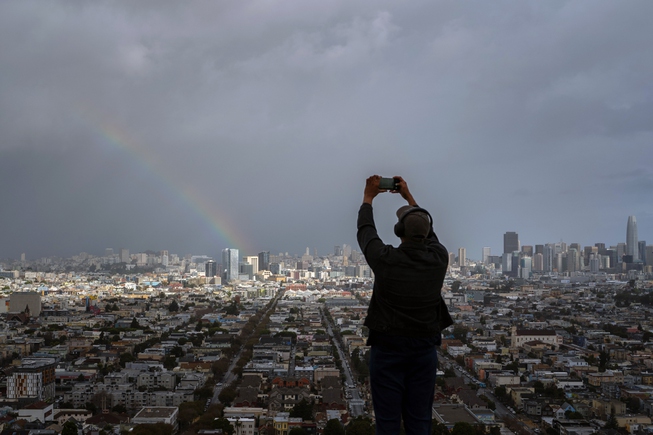
Loren Elliott / New York Times, file
A rainbow over San Francisco following heavy rains on Feb. 5, 2024. Before the state’s rainy season officially ends on Sunday, March 31, 2024, another storm is headed for the California coast.
Friday, March 29, 2024 | 2 a.m.
On Sunday, California’s rainy season officially comes to an end.
As a feature of its Mediterranean-type climate, California receives the vast majority of its annual precipitation between Nov. 1 and March 31. So by the time we’re entering April, we typically know how much water we’ll have to carry us through the rest of the year.
So how did this wet season stack up?
As of Tuesday, California had received slightly more rain than usual this winter — 104% of the average, according to state data. The state’s snowpack, which accumulates in the Sierra Nevada and typically provides 30% of the state’s water supply for the year, is at 101% of normal for this time of year.
The state’s reservoirs are at an even higher 116% of their normal levels, in part because they are still benefiting from the back-to-back “atmospheric rivers” that slammed California last winter.
“We’ve got a year, a second year in fact, when most of California was much wetter than average,” UCLA climate scientist Daniel Swain said in a recent online briefing. He said the current snowpack levels, while hovering around average, were remarkable, given that we’re “in an era where ‘average’ is not too accurate a descriptor of what happens most of the time.”
This winter wasn’t as wet as the last one, when the snowpack reached a historic high. And it has been warmer than last year and will probably continue to be, Swain said, so the snowpack will most likely melt more quickly than it did in 2023. But two consecutive wet years are still good news for abating any lingering drought conditions in California and for diminishing fire season.
Whether this winter was weirdly wet for you depends on where you live.
Los Angeles, which endured one of its wettest storm systems on record in February, had received 140% of its annual average rainfall as of Tuesday. Sacramento, by contrast, has gotten around 95% of its average.
Those figures could change before the wet season is officially up. It’s been raining in some northern parts of the state this week, snow began to fall in the Sierra yesterday and a big storm is headed to California in the coming days.
Rainy weather is expected to reach the Bay Area by Friday and then move down the coast over the weekend. In the Los Angeles region, the storm could drop as much as 6 inches of rain in the mountains and 3 inches in the lower, more populated areas, said Mike Wofford, a meteorologist with the Los Angeles-Oxnard forecasting office of the National Weather Service. He said a heavy storm this time of year was a feature of being in an El Nino climate pattern.
“It’s common to get some rain in March, and even in April,” Wofford said. “But normally we wouldn’t get the rain amounts that we’re getting this late in the season.”
This article originally appeared in The New York Times.
